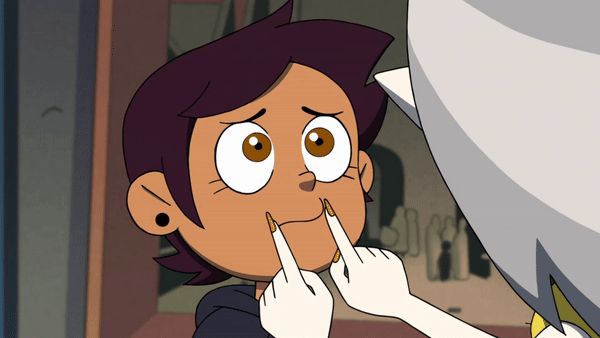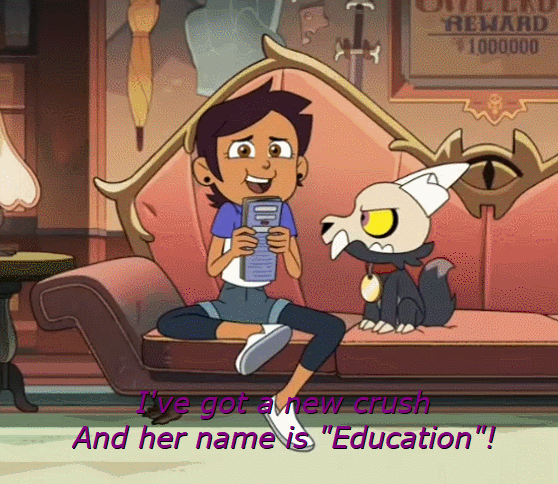Spoiler Warning: The Owl House (season 2)
The Owl House remains one of the most groundbreaking cartoons currently airing in terms of queer representation, particularly on a major network, as its air on the Disney Channel. The show features two canonically main queer characters, protagaonist Luz Noceda and bully-turned-friend Amity Blight, who is clearly being set up to be Luz’s love interest. The ship is called ‘Lumity’ by fans and show people alike. The show also features background queerness, and Eda the Owl Lady, Luz’s mentor and the show’s deuteragonist, was also hinted to be queer last year. Season two started airing a month ago, and creator Dana Terrace has only further unfurled a rainbow across her story.
With the second-most recent episode of The Owl House, Dana Terrace and her team have deepened Luz and Amity’s bond, the friendship falling into the gray space punctuated by longing, gay panic, and oh so many mutual blushes. The girls’ feelings for each other are swimming at the surface, and episode 2×05, ‘Through the Looking Glass Ruins’, ended with Amity spontaneously kissing Luz on the cheek, leaving both of them dumbfounded.
It is an honest-to-God delight to be watching this story unfold in real time. The incisive, beautiful writing makes viewers’ subsequent bisexual erasure all the more frustrating. While not common, two specific platforms erased Luz’s bisexuality when they referred to Lumity as a ‘lesbian’ ship, and the fact that they do at all reveals how pervasive bisexual erasure is.

The bisexual erasure with this show appears most concretely when some people talk about Lumity, as they call it a ‘lesbian’ ship. If both characters were lesbians, this description would be fine, as well as accurate, but when considering canon, it erases Luz’s bisexuality and contributes to the idea that lesbianism is the only kind of way a girl could be queer. It assumes that lesbianism is the queer default. Of course, I’ve seen this erasure on social media sites like Twitter and Tumblr, but Urban Dictionary and entertainment site The Gamer erased Luz’s bisexuality too.
Starting chronologically, Urban Dictionary has tweeted about Lumity several times over the past year, but its tweet on October 12th, 2020 ignited several replies and quote tweets in response. The site tweeted: “Lumity: An adorable lesbian ship between Luz Noceda x Amity Blight[.]” The definition, written by WildTrapper’s Dictionary, appeared on the site on August 20th, 2020. Urban Dictionary’s tweet led to a quick course correction by fans as a few definitions appeared the next day describing Lumity as a ‘sapphic’ ship, the term ‘sapphic’ an inclusive term for all women-loving-women. Notably, Urban Dictionary already had two definitions calling Lumity a “sapphic ship” in early October, yet they went with the one that called Luz a lesbian. Those specific, bi-inclusive definitions were posted on September 23rd, 2020 by LaurenIsATOHFan and MOTH6119, respectively. Urban Dictionary chose WildTrapper’s Dictionary’s definition over the other two, clearly not fact-checking.
Similarly, pop culture critic Jade King for The Gamer has mislabeled Luz just in the past two weeks. King has written a few articles about the show since May of this year, so she knows it well and must have rewatched it at least once. Her writings about the show’s queerness tend to focus on Amity’s arc, as her connection with Luz catalyzes character development that King calls “queer rebellion.” That term fits Amity well, especially this season. But nowhere in her articles does she mention Luz being bisexual, nor does she reference Luz expressing her bisexuality outside her relationship to Amity. This erases Luz’s attraction to boys, oversimplifying her sexuality. King then almost called Luz a lesbian for her second-most recent article.
Last week, in response to the Lumity cheek kiss, she released an article about how profound the episode is and will be for young queer viewers. For the lead picture, she used a screenshot of the girls superimposed over the lesbian flag, and then she summarized the episode as “culminating in a lesbian kiss that breaks boundaries in the world of modern animation.”

Tellingly, she also never mentions that Dana Terrace, the show’s creator and showrunner, is bisexual too. She silences the bisexuality embedded within this story by not even acknowledging its existence, presuming its absence. And her erasure of Luz’s bisexuality is all the more frustrating because King is a pansexual trans woman. Pansexuality falls under the broad bisexual+ umbrella, thus erasure comes part and parcel with pansexuality, and trans women also deal with erasure, hostility, and alienation from the cis gay community, hence the bi and trans communities being allies for decades.
Though The Owl House features queer characters and a queer romance, the show is specifically a bisexual narrative. In a Reddit AMA last year, Terrace — who is bisexual herself — confirmed that Luz is bisexual and Amity a lesbian. Fans, however, had already been guessing that, particularly Luz’s sexuality, since hers was telegraphed early on.
In 1×02, ‘Witches Before Wizards’, Luz encounters Nevareth, a character who parodies the muscular, angst-ridden male love interest to female protagonists in YA. Luz expresses attraction to him, including when he takes off his shirt, revealing his abs. Then in 1×12, ‘Adventures in the Elements’, Luz says, “I’ve got a new crush, and her name is Education!” That same episode features her budding friendship with Amity, which deepens even more in the subsequent prom episode that confirms that Amity likes Luz. Terrace bolstered the bisexual-ness of her story by incorporating bi pride colors and bi tropes throughout the first season.

Terrace hosted that AMA on September 2nd, weeks before Urban Dictionary sent out that tweet and months before King started writing about The Owl House. Wikipedia updated the show page to include this source within three weeks of the AMA, so whoever handles Urban Dictionary’s Twitter and Jade King could have easily verified Luz’s sexuality without doing much research and without even having to watch the show.
Ignoring blatant bisexual markers, like Luz’s fascination with Nevareth’s chiseled muscles and her gendering of education, feeds into another aspect of bisexual erasure in media. There exists this thread of fiction that refuses to acknowledge or show a character as being bisexual unless that bisexual person is in a relationship, or potential relationship, with someone else. That a bisexual person’s “true” sexuality is predicated on the relationship and whichever gender she chooses. A bisexual character cannot express bisexuality on her own — she needs to be involved with a love triangle or have a complicated romantic past.
All of this, particularly King’s writings about The Owl House, reminds me of Anna Akana’s frustration with viewers after Magical Girl Friendship Squad came out last year. Akana, a bisexual actress, voiced main character Daisy, asserted Daisy was bisexual like her. Some viewers tried to contest her tweets and skipped over Akana’s concern over bisexual erasure, focusing on Daisy’s disputed gender. It’s the public ignoring a bisexual artist’s statements on her own work, as well as tell-tale signs of bisexuality within the actual text.
Often bisexual erasure stems from careless assumption about sexuality and binaries, as bisexual erasure, a component of an issue known as ‘compulsory monosexuality’, does not rely on conscious or bigoted intentions. Those things can motivate bisexual erasure but not always. ‘Compulsory monosexuality’ encourages a worldview that people fall either into the straight or gay category, oversimplifying fictional relationships like Lumity. And this isn’t the mid-twentieth century. ‘Lesbian’ is not an umbrella term for women-loving-women like ‘sapphic’ is, not anymore at least. Second-wave feminism and lesbian separatism, as well as bi women pushing against erasure, helped to solidify those boundaries between labels.
So next time a bisexual female character debuts on-screen, can we all please respect the labels she may use or the labels her creators may give her? Creators have a responsibility to thoughtfully portray characters from a marginalized background, but viewers like us also have the responsibility to recognize the nuances that play out.
And until the next episode drops this weekend, I highly recommend this fan video tribute to Luz’s bisexuality. It celebrates Lumity while still uplifting Luz as the bisexual protagonist of our dreams, first and foremost. Bi for now, readers, bi for always!
Images courtesy of Disney Television Animation
Have strong thoughts about this piece you need to share? Or maybe there’s something else on your mind you’re wanting to talk about with fellow Fandomentals? Head on over to our Community server to join in the conversation!

